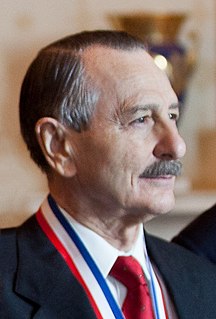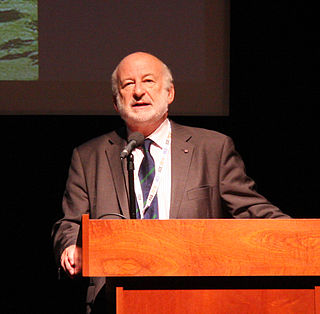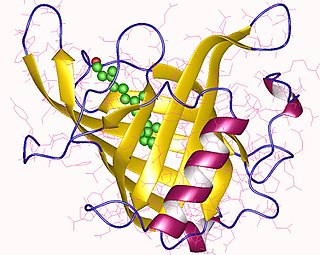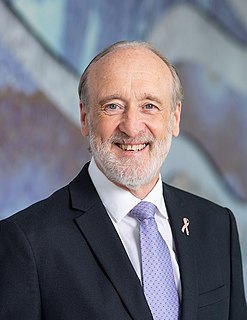
Interferons are a group of signaling proteins made and released by host cells in response to the presence of several viruses. In a typical scenario, a virus-infected cell will release interferons causing nearby cells to heighten their anti-viral defenses.

Estrone (E1), also spelled oestrone, is a steroid, a weak estrogen, and a minor female sex hormone. It is one of three major endogenous estrogens, the others being estradiol and estriol. Estrone, as well as the other estrogens, are synthesized from cholesterol and secreted mainly from the gonads, though they can also be formed from adrenal androgens in adipose tissue. Relative to estradiol, both estrone and estriol have far weaker activity as estrogens. Estrone can be converted into estradiol, and serves mainly as a precursor or metabolic intermediate of estradiol. It is both a precursor and metabolite of estradiol.
Texas A&M College of Agriculture and Life Sciences, or AgLifeSciences for short, is one of ten colleges and schools that are part of Texas A&M University. Agriculture and the Life Sciences have been part of the university since its founding in 1876 as the "Agricultural & Mechanical College of Texas." The College was formally recognized in 1911. A part of the land grant university system, the college offers more than 80 undergrad and grad degree programs across 14 departments. It is also one of the five organizations that comprise Texas A&M AgriLife.

The Babraham Institute is a life sciences research institution and a partner organisation of the University of Cambridge. The Babraham Institute is based on the Babraham Research Campus, partly occupying a former manor house, but also laboratory and science facility buildings on the campus, surrounded by an extensive parkland estate, just south of Cambridge, England. It is an independent and charitable organization which is involved in biomedical research, including healthy aging and molecular biology. The interim director is Dr Simon Cook who also leads the Institute's signalling research programme.
Interferon tau is a Type I interferon made of a single chain of amino acids. IFN-τ was first discovered in ruminants as the signal for the maternal recognition of pregnancy and originally named ovine trophoblast protein-1 (oTP-1). It has many physiological functions in the mammalian uterus, and also has anti-inflammatory effect that aids in the protection of the semi-allogeneic conceptus trophectoderm from the maternal immune system.

C. E. Byrd High School, a Blue Ribbon School, is a high school in Shreveport, Louisiana, United States. In continuous operation since its establishment in 1925, C. E. Byrd is also the eighth-largest high school in the state of Louisiana as of February 2019. Byrd students come from its neighborhood or throughout the entire Caddo Parish school district through its selective math/science magnet program.

Jan T. Vilček is a biomedical scientist, educator, inventor and philanthropist. He is a professor in the department of microbiology at the New York University School of Medicine, and chairman and CEO of The Vilcek Foundation. Vilček, a native of Bratislava, Slovakia, received his M.D. degree from Comenius University Medical School, Bratislava in 1957; and his Ph.D. in Virology from the Institute of Virology, Czechoslovak Academy of Sciences, Bratislava, Czechoslovakia in 1962. In 1964, Vilček, with his wife Marica, defected from Communist Czechoslovakia during a three-day visit to Vienna. In 1965, the Vilčeks immigrated to the United States, and have since lived in New York City. Vilček devoted his scientific career to studies of soluble mediators that regulate the immune system (cytokines), including interferon and tumor necrosis factor (TNF).

Yasutomi Nishizuka, MJA, ForMemRS was a prominent Japanese biochemist and made important contributions to the understanding of molecular mechanism of signal transduction across the cell membrane. In 1977, he discovered protein kinase C, which plays significant roles in a variety of intracellular signal transduction processes.

Ralph Lawrence Brinster is an American geneticist, National Medal of Science laureate, and Richard King Mellon Professor of Reproductive Physiology at the School of Veterinary Medicine, University of Pennsylvania.
R. Michael Roberts is an American biologist and a Curators' Professor of animal science at the University of Missouri. He is a founding co-editor of the Annual Review of Animal Biosciences, first published in 2013.

Karl Maramorosch was an Austrian-born American virologist, entomologist, and plant pathologist. A centenarian and polyglot, he conducted research on viruses, mycoplasmas, rickettsiae, and other micro-organisms; and their transmission to plants through insect vectors in many parts of the world. He is the co-author of a textbook on techniques in virology and is the author of numerous papers on the biology and ecology of plant viruses, their hosts, and vectors. He received the Wolf Prize in Agriculture in 1980 for his contribution to the study of crop pathogens.

John Anthony Pickett CBE DSC FRS is a British chemist who is noted for his work on insect pheromones. Pickett is Professor of Biological Chemistry in the School of Chemistry at Cardiff University. He previously served as the Michael Elliott Distinguished Research Fellow at Rothamsted Research.

Edward Michael De Robertis is an American embryologist and Professor at University of California, Los Angeles, whose work has contributed to the discovery of conserved molecular mechanisms of embryonic inductions that cause tissue differentiations during animal development.
Hormonal regulation occurs at every stage of development. A milieu of hormones simultaneously affects development of the fetus during embryogenesis and the mother, including human chorionic gonadotropin (hCG) and progesterone (P4).

Anthony Rex Hunter is a British-American biologist who is a Professor of Biology at the Salk Institute for Biological Studies and the University of California San Diego. His research publications list his name as Tony Hunter.

John J. Tyson is an American systems biologist and mathematical biologist who serves as University Distinguished Professor of Biology at Virginia Tech, and is the former president of the Society for Mathematical Biology. He is known for his research on biochemical switches in the cell cycle, dynamics of biological networks and on excitable media.

Retinol-binding proteins (RBP) are a family of proteins with diverse functions. They are carrier proteins that bind retinol. Assessment of retinol-binding protein is used to determine visceral protein mass in health-related nutritional studies.

Peter J. Hansen is an American animal scientist and physiologist who serves as distinguished professor and L.E. "Red" Professor of Animal Sciences in the Department of Animal Sciences at University of Florida

Maternal recognition of pregnancy is a crucial aspect of carrying a pregnancy to full term. Without maternal recognition to maintain pregnancy, the initial messengers which stop luteolysis and promote foetal implantation, growth and uterine development finish with nothing to replace them and the pregnancy is lost.

Robert Clarke is a Northern Irish oncology researcher and academic administrator. He is the executive director of The Hormel Institute, a professor of biochemistry, Molecular Biology and Biophysics at the University of Minnesota, and ab Adjunct Professor of Oncology at Georgetown University.















